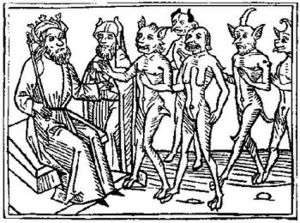
Back بليعال Arabic Belial Catalan Bélial Czech Belial German Belialo Esperanto Belial Spanish Belial Basque Belial Finnish Bélial French בליעל HE

Belial (/ˈbiːli.əl/;[1] Hebrew: בְּלִיַּעַל, Bəlīyyaʿal) is a term occurring in the Hebrew Bible/Old Testament which later became personified as the devil[2] in Christian texts of the New Testament.[3] Alternate spellings include Baalial, Balial, Belhor, Beliall, Beliar, Berial, Bylyl and Beliya'al. In the Secret Book of John, an early Gnostic text, the ruler of the underworld is referred to as Belias.[4]
- ^ "Belial". Dictionary.com Unabridged (Online). n.d.
- ^ See the reference to "Beliar" in The Ascension of Isaiah, at EarlyChristianWritings.com, specifically at 1:8–9, 2:4, 3:11–13, 4:2, 4:14–18, 5:1, 5:15.
- ^ Floyd, Michael H. (2000). Minor Prophets: Volume 2. Grand Rapids, Michigan: Wm. B. Eerdmans Publishing Company. p. 46. ISBN 978-0802844521.
In late biblical times beliya'al came to designate a mythic personification of evil, and Belial thus became the name of a satanic figure... Two considerations militate against this sort of reading, one historical and the other grammatical. First, the mythic personification of Belial appears to have been a rather late development, and there is no good reason to suppose that beliya'al had assumed this meaning by the time Nahum was composed. There is no evidence of a satanic figure named Belial in biblical or extrabiblical literature from earlier than the third century BC (T. J. Lewis, "Belial," ABD 1 :655–56), and most scholars would date the final edition of ..
- ^ Marvin Meyer; Willis Barnstone (30 June 2009). "The Secret Book of John". The Gnostic Bible. Shambhala. Retrieved 1 February 2022.
© MMXXIII Rich X Search. We shall prevail. All rights reserved. Rich X Search